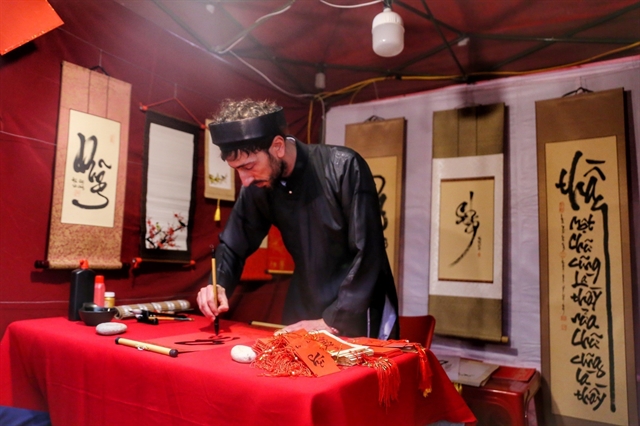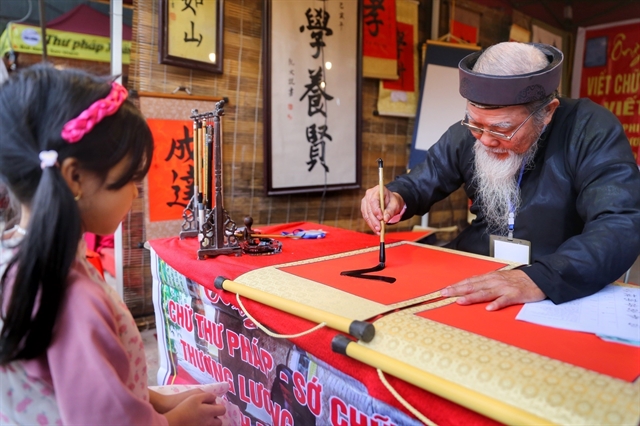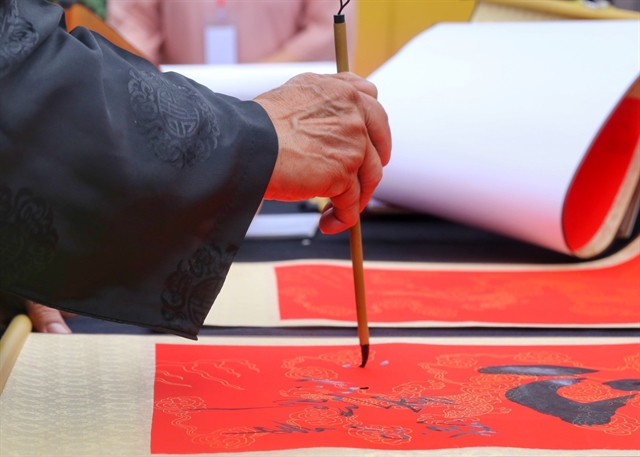 Society
Society


|
| Jean Sebastien Grill writes calligraphy at the annual Spring Calligraphy Festival in Hà Nội. — VNA/VNS Photos Tuấn Đức |
Vân Nguyễn & Minh Phương
Jean Sebastien Grill in his áo dài (a Vietnamese traditional outfit) calmly dips the brush into the black ink to write a calligraphy on red paper for a local man in Hà Nội.
The French calligrapher then gives the painting with the word “phúc” (which means blessing or happiness) on it to the young Hanoian.
“I wish the new year blesses him with lots of blessings and happiness,” Jean said.
The French man is among 50 calligraphers who have gathered in Hồ Văn (Literature Lake) of the Văn Miếu-Quốc Tử Giám (Temple of Literature Complex) to join the annual Hội chữ Xuân (Spring Calligraphy Festival) to showcase their calligraphic skills.
The festival is held after being postponed for two years due to the COVID-19 pandemic and aims to introduce local and international visitors an old tradition of displaying calligraphic works during Tết (Lunar New Year). Vietnamese calligraphy is a written form of visual art, reflecting the virtue, rights, and dreams of people as well as the inspiration of the writer.
Calligraphy paintings are often decorated at home with the hope of a wonderful new year.
Calligraphers say they are excited to write again and hope this art will be well preserved.
Nguyễn Văn Thuyết, a local calligrapher, said: “Nowadays calligraphy has been revived strongly in Việt Nam and local people are excited with this art of calligraphy.

|
| This year's festival attracted 50 calligraphers. |
“The festival is a great opportunity for me to write calligraphy. And I hope to transfer my knowledge to the public. Many people have longed for this, especially after two-year hiatus due to COVID-19.”
There are two main genres of calligraphy, one featuring calligraphic works using Chinese characters and the other using the Latin-based Vietnamese alphabet. Both educate us about good things in life, Thuyết said.
In days gone by, calligraphers were respected scholars who gave away their work for free.
Nowadays this tradition is observed mostly in festivals and still attracts people passionate about it.
Jean said: “I like calligraphy. It’s a way to use our energy to write words and help others.”
His love for writing started a long time ago and has been nurtured.
He added: “I loved writing since I was small. I wrote here, there, and everywhere when I was a child. When I met an old man writing calligraphy, I immediately felt for it, making me learn about this art.
"I started to learn about calligraphy in South Korea with an old man, it was about seven years ago. When I travelled to Việt Nam, I continued to learn about this art from a local teacher.”
Festival goers say this is a great opportunity to introduce culture to young generations.
Trần Thị Hường, said: “I take my children here to learn and appreciate the traditional art and culture of Việt Nam.
“Vietnamese art and culture are very beautiful. These simple words have very deep meaning and lessons for the children.”

|
| A calligrapher uses a brush with black ink to write on red paper. |
Gabriela Sonder, a Brazilian visitor, said: “I have never heard of this and this is so interesting. The details are so precise.
“It’s so beautiful and I think it has such a deep meaning. And I think traditions are something big here which you can really see through paintings. It has been going on for so many generations.” — VNS